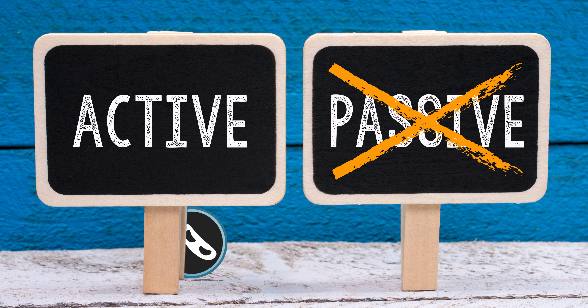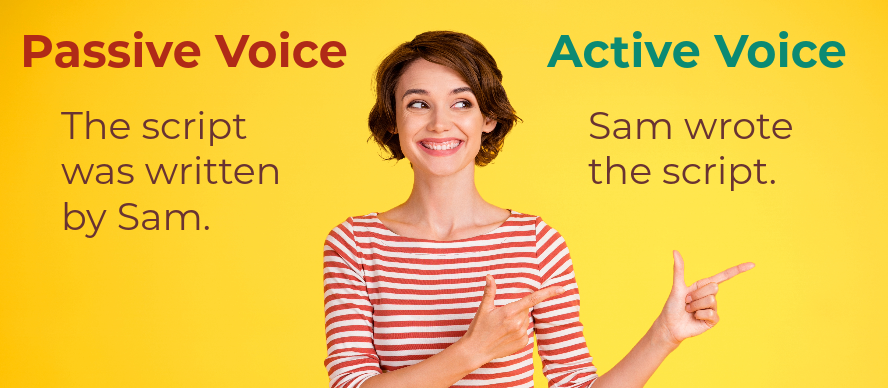Mastering the Art of Active Voice
Want a quick trick to make your stories more engaging? Write in an Active Voice! Read on to discover what “Active Voice” is and how to incorporate it into your stories.

Noi Sabal
Founder

9 min read • 2,281 words
As a screenwriter, novelist, or fiction writer, you need to know one crucial, underrated writing trick that can quickly captivate your Reader: the use of “Active Voice.” Active Voice in writing is when the subject of a sentence (a character) does something — and you describe it (usually in the Present Tense). This makes your writing more direct and engaging for the Reader. When you write in an Active Voice (instead of Passive Voice), your story comes to life by injecting energy into your characters, dialogue, and world — all through word choice.
In this blog post, we’re going to explore the differences between active and Passive Voice, shed light on what Active Voice means in writing, why it’s important (especially in screenwriting!), explore the ins and outs of using Active Voice, and ultimately give you a list of actionable tips to master the art of using Active Voice in your writing. So, let’s dive in!

1. What is Active Voice in Writing?
Active Voice in writing refers to crafting sentences where the subject clearly performs the action. This dynamic writing style offers clarity, immediacy, and a sense of movement to your screenplay. Active Voice enables your script to come alive, allowing the audience to become actively engaged in your story.
Basically, it’s a writing style in which the subject of a sentence performs the action. The Active Voice focuses on the doers and their actions, lending a sense of immediacy and engagement to your story. In screenwriting, we often strive for an Active Voice because it keeps the story moving forward and creates a sense of urgency.
2. Active vs. Passive Voice
Wait… What exactly is the difference between Active and Passive Voice?
• Active Voice has the subject of the sentence as the “doer” of the action. So, the character actively does the action.
• Passive Voice puts the focus on the action itself. It emphasizes the recipient of the action, which can lead to a more detached and less engaging narrative.

EXAMPLE: Imagine a scene where a protagonist, Max, confronts his arch-nemesis, Dr. Evil. Instead of writing, “Max is taunted by Dr. Evil,” which is a detached, Passive Voice, we can go for an active approach: “Dr. Evil taunts Max,” instantly making the confrontation more dynamic and engaging.
Or how ’bout in a chase scene? You could write, “Detective Jones is being chased by a mysterious figure.” — where the Mysterious Figure is the Doer (doing the action), and Detective Jones is passive (things are happening to him). But what if we switch it up and make it Active Voice: “A mysterious figure chases Detective Jones.” See how the Active Voice adds a bit of energy to the sentence?
Let’s take a look at a classic Active Voice screenplay example from the original “Rocky” (1976, written by Sylvester Stallone):
“Rocky’s bloody teeth snarl at Apollo and he waves him to come ahead and fight toe to toe… Apollo obliges with a weary but effective burst of rights and lefts that have K.O. written on every punch. Rocky counters the assault blow for blow.”
Notice how the Active Voice of this excerpt not only captures the action (what happens in the scene), but also helps the Reader connect with both boxers (intimating how being in the action feels). It embodies the tone for the thrilling final match (pg 113) between the underdog Rocky and the reigning champion Apollo Creed.
Active Voice makes your writing dynamic.
3. Using Active Voice in Screenwriting
While both Active and Passive Voice have their place in all fiction writing, screenwriters usually employ Active Voice because of a screenplay’s inherent visual and active nature. So, let’s dive into how to develop a script using Active Voice.

The screenwriter’s motto is “Show, Don’t Tell,” right? Why? Because film is a visual medium, screenplays must paint a picture with words. And because Active Voice effectively conveys the actions and emotions of characters in an immediate, often visual way, it is highly preferred by screenwriters. Using it in your dialogue and descriptions brings your scenes to life, creating a vivid and immersive experience for the viewers.
Active Voice ensures that your screenplay maintains a brisk pace, preventing it from feeling stagnant or passive. It injects energy into your writing, heightening each moment’s tension, excitement, or drama. By using Active Voice, you can deliver a compelling, engaging, and ultimately more marketable screenplay.
Passive Voice, on the other hand, tends to slow down the pacing and can make your script feel less engaging.
But that doesn’t mean Passive Voice has no place in scripts! It can absolutely still be effectively used — especially when you strategically add it to punctuate a scene or action. Passive Voice is fabulous for highlighting a character’s passivity, conveying a specific tone or mood, or emphasizing a particular moment or action. When you use it sparingly — and with a clear purpose in mind — Passive Voice can make quite an impact when nestled in amongst a script full of Active Voice. But, in most cases, Active Voice reigns supreme in script development.
Active Voice makes your scenes come to life.
4. Why Active Voice is Important in Scripts
While all fiction (like novels and short stories) can benefit from using Active Voice, it’s essential when screenwriting. Let’s take a quick look at why.
Top 5 Reasons Scripts Use Active Voice
REASON 1: It Makes Your Words Count (to make your Page Count!)
In screenwriting, brevity is key. With Active Voice, you can convey the same message with fewer words, eliminating unnecessary clutter and allowing your script to be more concise. By adopting an Active Voice, you’ll cut through the noise and deliver impactful scenes that resonate with your audience and keep them hooked from start to finish. Active Voice not only elevates your storytelling but can also streamline your script. And since “Short and sweet can’t be beat!” using Active Voice will save you some precious space in that 120 pages.
REASON 2: It Streamlines Action Sequences
Action sequences are the bread and butter of many screenplays. They demand a vibrant and Active Voice to reach their full potential. Let’s compare the following examples:
— Passive Voice: “The car was driven by John, and the gun was shot out the window by Sarah.”
— Active Voice: “John drove as Sarah shot out the window.”
Switching to an Active Voice trims unnecessary words and brings your Reader closer to the heart-pounding moments, heightening the tension and excitement.
REASON 3: It Drives the Beats
Rhythm is essential in screenwriting, especially when it comes to Action. Screenplays should read smoothly, allowing your Reader to effortlessly visualize the story. Active Voice naturally lends itself to maintaining a steady pace, keeping people engaged throughout the script. By avoiding lengthy, passive sentences, you can maintain the rhythm and flow, ensuring your scenes come together in a story that feels seamless (and captivating!). The Active Voice enables your Reader to absorb information quickly, ensuring they remain fully immersed in your script.

REASON 4: It Creates Engaging Characters
In screenwriting, characters are the heartbeat of your story. By utilizing the Active Voice, you can make your characters come alive, ensuring they take center stage. Instead of writing something like, “Mary is being chased by the monster” (which doesn’t really have immediate, emotional stakes for Mary), you can opt for something more active, emotional, and current: “The monster stalks Mary.” This simple swap places Mary in the spotlight, conveys a feeling, and paints a picture of the action unfolding before the Reader’s eyes.
REASON 5: It Conveys Intent & Emotion
Active Voice has a unique way of conveying intention and emotion. By providing clarity and simplicity, it allows the writer to focus on the character’s motivations and feelings. Consider the following examples:
— Passive Voice: “The jacket was put over her shoulders by Tim.”
— Active Voice: “Tim draped his jacket over her shoulders.”
By using Active Voice, the latter example emphasizes the giver’s actions and intentions, evoking a more intimate and emotionally charged scene.
Active Voice drives your story and makes it compelling.
5. Tips for Writing in Active Voice
Now that we’ve dug into what Active Voice is and why it’s essential, here are some practical tips to help you master this powerful writing technique.
Practical Tips for Writing Active Voice
1. Identify the subject: Ensure that the subject of your sentence is the one performing the action. This creates a clear and Active Voice that resonates with your audience.
2. Use strong verbs: Choose impactful and action-oriented verbs to heighten the intensity of your scenes. Strong verbs infuse your screenplay with energy and excitement, making it more compelling to the audience.
3. Keep sentences concise: Active Voice thrives on conciseness. Use shorter sentences to maintain the momentum and avoid convoluted phrasing that can dilute the impact of your words.
4. Focus on visuals: Screenwriting is all about visualization. Incorporate vivid descriptions and active imagery that allow the audience to envision the scene as if they were witnessing it firsthand.
5. Write in present tense: The use of present tense enhances the immediacy of your script, creating a sense of urgency and immersion for your audience.
6. Edit ruthlessly: During the editing process, pay close attention to sentence structure and phrasing. Watch out for instances of Passive Voice that may have slipped through. Trim unnecessary words or phrases that hinder the active flow of your screenplay.
Active Voice creates a sense of immediacy to engage Readers.
6. Active Voice Examples
When you use Active Voice, you’ll infuse your writing with an extra dose of excitement and keep your viewers on the edge of their seats. Here are a few Active Voice examples:
Active Voice in Screenwriting Examples
• Darla’s eyes dart around the empty hallway, searching for the source of echoing footsteps.
• Mark pushes through the crowded street, desperately searching for his daughter.
• Sam hurtles over the fence, narrowly missing the already bloody barbed wire.
• Emma throws herself against Chris, crying with joy but pummeling his chest.
• Sam races across the paintball field in a final sprint to reach the flag first.
• Rebecca confronts her mother… and finally musters the courage to forgive her.
Examples of Active vs. Passive Voice
Here are two versions of the same basic concept that can help you see the difference between Active & Passive Voice:
ACTIVE Voice: Sharon kicks the door down.
PASSIVE Voice: The door is kicked open by Sharon.
ACTIVE Voice: The detective grills the suspect.
PASSIVE Voice: The suspect is skillfully interrogated by the detective.
ACTIVE Voice: The crowd cheers for the team.
PASSIVE Voice: The team is cheered for by the crowd.
ACTIVE Voice: The villain pulls back the trigger…
PASSIVE Voice: The trigger is pulled by the villain.
ACTIVE Voice: The boxer pummels his opponent.
PASSIVE Voice: The opponent is punched by the boxer.
ACTIVE Voice: The sniper zeros in on his target.
PASSIVE Voice: The target is aimed at by the sniper.
ACTIVE Voice: The city convulses from the earthquake.
PASSIVE Voice: The city is violently shaken by the earthquake.
ACTIVE Voice: The surfer cruises along the enormous wave.
PASSIVE Voice: The enormous wave is fearlessly ridden by the surfer.
ACTIVE Voice: The professor excites her students.
PASSIVE Voice: The students are excited by the professor.
ACTIVE Voice: The architect designs the skyscraper.
PASSIVE Voice: The skyscraper is designed by the architect.
ACTIVE Voice: The hacker sidesteps the security system.
PASSIVE Voice: The security system is skillfully bypassed by the hacker.
ACTIVE Voice: The athlete effortlessly clears the high jump.
PASSIVE Voice: The high jump is effortlessly cleared by the athlete.
ACTIVE Voice: The assassin closes in on her target.
PASSIVE Voice: The target is stealthily approached by the assassin.
ACTIVE Voice: The firefighter rescues the trapped dog.
PASSIVE Voice: The trapped dog is rescued by the firefighter.
ACTIVE Voice: The race car driver zips through the track.
PASSIVE Voice: The track is skillfully maneuvered through by the race car driver.
ACTIVE Voice: The surgeon expertly completes the life-saving procedure.
PASSIVE Voice: The life-saving procedure is carefully completed by the surgeon.
ACTIVE Voice: The archaeologist makes an astonishing discovery.
PASSIVE Voice: An astonishing discovery is made by the archaeologist.
Active Voice makes your writing more exciting!
BONUS TIP: Present Tense
When you’re ready to up your game, combine Active Voice with Present Tense! Present Tense simply means the events described are happening in the present moment. By using Active Voice and Present Tense in your story, you bring a sense of immediacy and energy to your writing. It helps engage your Reader and makes them feel like they’re right there in the thick of the action. So, when you want your script, book, or story to feel lively and captivating, rock that Active Voice and Present Tense combo!

Conclusion
If you want to write like a pro, use Active Voice! Don’t underestimate the power of this simple trick — especially in screenwriting. It’s the key to creating a dynamic, immersive screenplay that hooks your viewers from the first page. This simple, invaluable writing trick — keeping your tense Active and Current — will help you bring your characters to life, energize dialogue, streamline action sequences, enhance readability, convey intent and emotion, maintain rhythm, and make every word count.
Mastering the art of using Active Voice is a valuable pro writing skill that will undoubtedly elevate the impact of your stories. It can give your stories that extra oomph that will keep your Reader engaged from start to finish. So, go forth and actively conquer the blank page! And remember, when you embrace the Active Voice, your writing will leap off the page, into your Reader’s imagination, and, ultimately, onto the big screen!
Recent Articles
The Ultimate Guide to Writing a Logline (with tons of logline examples and Video Tutorial!)
Need a Logline for your script or novel? Discover an easy formula in a step-by-step video, download a Logline Examples PDF & spark creativity with a Logline Generator from Writing Ninja
The Ultimate Guide to Theme in Screenwriting
Ready to elevate your writing? Using Theme in screenwriting can be a game-changing secret weapon. Dive into...
It’s Screenplay Season! Time to Download & Read the Best Scripts of the Year
Looking for scripts? We have the most comprehensive list of downloadable screenplay pdfs for the 2022 awards season....

Writing Ninja is an online story development platform that makes it really easy for writers to create professional quality stories for screenplays and novels.
Membership
Features
Why Writing Ninja
Company
On the Ninja Blog
The Ultimate Guide to Writing a Logline (with tons of logline examples and Video Tutorial!)
Need a Logline for your script or novel? Discover an easy formula in a step-by-step video, download a Logline Examples PDF & spark creativity with a Logline Generator from Writing Ninja
The Ultimate Guide to Theme in Screenwriting
Ready to elevate your writing? Using Theme in screenwriting can be a game-changing secret weapon. Dive into storytelling...




